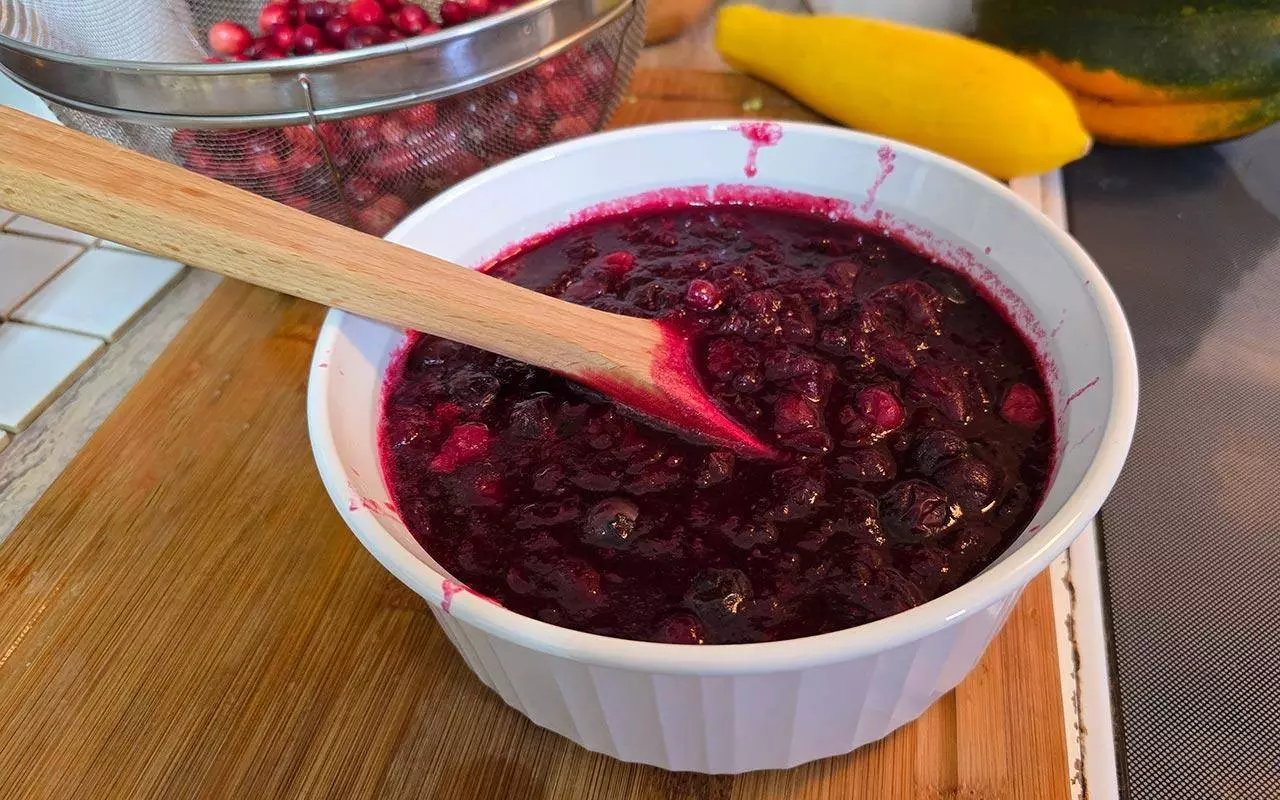Cranberry sauce and cranberry jelly have been Thanksgiving staples for most Americans for more than 400 years. I get it, traditions are good but I wanted to create something unique, more flavorful and more authentic as an alternative. When it comes to culinary traditions found among historical records of the Wampanoag and other Northeastern Tribes, such as the Narragansett, berries were clearly a favorite. Not only do they taste great and are packed with nutrients but they are also plentiful and grow naturally - as long as you know when and where to look of course! So, in honor of Native American Heritage Day and just because I love traveling through my tastebuds, I've created this recipe for Wampanoag Inspired Maple, Blueberry, and Cranberry Sauce.
I tried to place myself in the footsteps of a hungry man looking for something to go with his venison steaks and I couldn't think of anything more satisfying than a delicious sauce like this that is easy to make from gathered ingredients native to what is today known as New England. The indigenous peoples of the northeastern woodlands were known to harvest and utilize this tart berry, which grew abundantly in the region's wetlands and bogs but like other native foods such as blueberries, maple syrup, and walnuts, it rapidly became popular among the colonists too.
In particular, this vibrant red cranberry, known as "sassamenesh" to the Wampanoag people and "atoqua" to the Algonquin, has been an integral part of Native American culture for thousands of years before European colonization. However, similar berries are found all over the world and so it is believed that the English settlers who began arriving in Massachusettes in the mid-1600s already had an appetite for them. That is speculation but what we do know is that there are historical records indicating that there was a high demand for them and enterprising members of local tribes began to use them as a valuable commodity in trade with the English. Ultimately barrels of them were even sent back to England as a gift to the King and his royal court!
Indigenous Uses and Cultural Significance
The Wampanoag and other indigenous northeastern American tribes used cranberries not just for food but also for medicine and even dye for clothing, jewelry, as well as for bait used in rabbit traps. Aside from eating them raw and creating sauces, cranberries were also incorporated into a high-energy food called pemmican by combining crushed cranberries with dried deer meat and animal fat. This preserved mixture served as a crucial food for survival during long winters and journeys for people throughout the region. While more popular among western tribes such as the Ojibway, Cree, Algonquian, and Lakota, it is believed that people in this area also created something similar.
The berries were also used medicinally to treat wound infections and as a blood purifier. Native healers recognized the berry's natural preservative properties, using it to treat meat and as a poultice for wounds. The deep red juice also served as a natural dye for rugs, blankets, and clothing.
Traditional Cranberry Harvesting Methods
Indigenous peoples developed sophisticated harvesting techniques, collecting cranberries in the fall when the berries reached their peak ripeness. They would wade into the bogs to hand-pick the berries, or use specialized wooden scoops they developed for more efficient gathering. The harvested berries were then dried in the sun for preservation.

Health Benefits for Men Who Eat Cranberries
Recent scientific research has validated many of the traditional medicinal uses of cranberries, particularly highlighting their benefits for men's health:
Prostate Health
Rich in proanthocyanidins, cranberries may help maintain prostate health and reduce inflammation.
Urinary Tract Health
While commonly associated with women's health, cranberries also help prevent urinary tract infections in men.
Heart Health
The polyphenols in cranberries support cardiovascular health by reducing blood pressure and inflammation.
Cancer Prevention
Studies suggest cranberries may help prevent certain types of cancer, including prostate cancer.
Dental Health
Compounds in cranberries prevent bacteria from adhering to teeth, reducing plaque formation.
Immune Support
High vitamin C content supports overall immune function.
Many of these benefits are also great for women's health, and as someone who is working hard to focus on natural foods and a low glycemic index diet, I think it's a great choice for a punch of flavor. This is especially true when you use maple syrup as a sweetener instead of sugar. Compared to processed sugar, 100% organic maple syrup contains no additives, minimal processing, tons of nutrients, and has a glycemic index of 54 vs 65.
In comparison, High-fructose corn syrup has a Glycemic Index (GI) rating of 87, making it one of the worst sweeteners in terms of how fast it causes your blood sugar to rise, while Agave Nectar at only around 10 is one of the better ones to use and a favorite of ours for cooking healthy treats.
This note about lower GI sweeteners is important because we are using Concord grape juice in our recipe and so it is essential to look at the ingredients and select a variety that does not have any High Fructose Corn Syrup (HFCS) in it. While you can look at the nutrition information on the labels, the other way to notice the difference is that these no-sugar-added products are often twice the cost because they aren't filled with artificial ingredients.
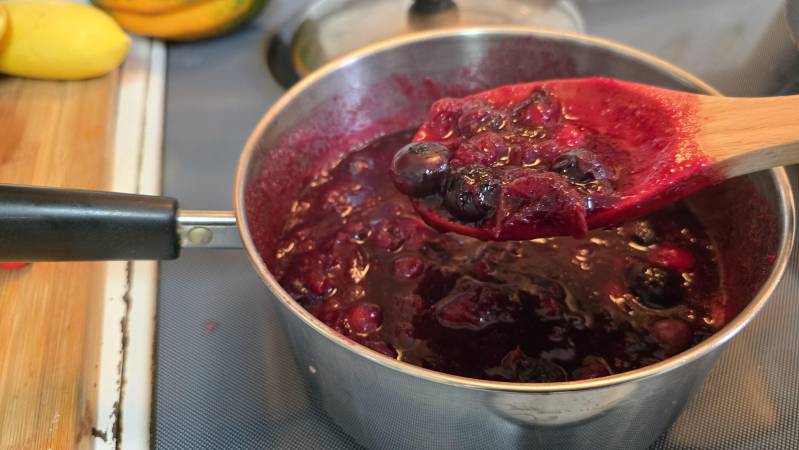
Maple, Blueberry, and Cranberry Sauce Recipe
This recipe is my own creation inspired by the available ingredients and culinary traditions. While I enjoy the tart, fruity nature of this recipe for how it serves to truly enhance a gamey protein like venison or water fowl, I appreciate that many folks see cranberry sauce as more of a sweet side dish ... vs serving as a relish to complement your meat. If you like things more sweet and jelly like, simply add extra maple syrup and cook the mixture down more so that it gets thicker as well.
Remember, the important thing is that we're cooking to understand another culture. The truth is that with the arrival of European colonists, indigenous cooking changed rapidly as well. Salt, spices, and other items such as metal pans and knives were quickly incorporated into their traditions and in the centuries since ... these native people's tastes have continued to evolve as well.
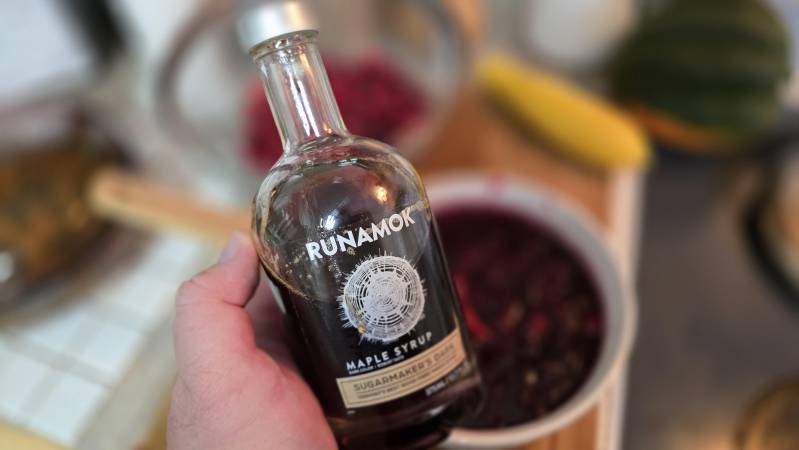
One key element of this transition is sugar was that while maple syrup is historically accurate - the process originally consisted of allowing the containers holding the sap to freeze - so that water could be separated from the sugary maple syrup. Quickly, though, this transitioned to boiling it and creating the maple syrup we know and love today. This Sugarmaker's Dark wood-fired maple syrup from Runamok is as authentic as we could get since most modern maple syrup is produced in giant industrial processes, but this one is reduced over a wood fire for that bolder extra special robust flavor.
Ingredients:
- 4 cups fresh cranberries
- 1 cup Concord grape juice (Concord Grapes are part of the Vitis Labrusca family and a close modern relative to native fox grapes that existed throughout the region prior to the colonial period)
- 1/2 cup pure maple syrup (We used Runamok Sugarmaker's Dark Wood-Fired maple syrup)
- 1/4 cup blueberries
- 1 cup chopped walnuts
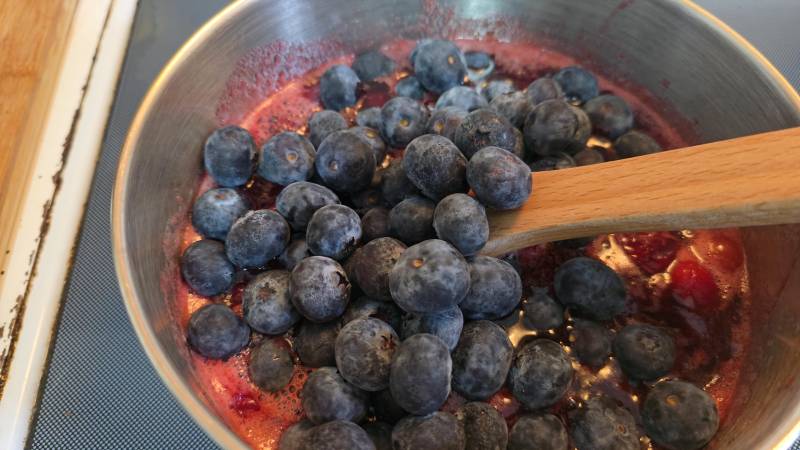
Instructions:
Add the cranberries, maple syrup, and grape juice to a medium saucepan over low heat and simmer till the cranberries soften and the mixture begins to thicken. Some people refer to this process as "popping" because the cranberries will actually explode as the water inside turns to vapor. Throughout this period you will want to stir the sauce periodically so that it doesn't burn. You will also want to keep a lid on between stirring so that the popping cranberries don't splatter red juice all over your kitchen!
Once they are softened, you'll want to blend them - modern cooks can use an immersion blender - but since we're trying to be more authentic, I'm actually going to crush them a bit but leave nice big chunks. Cranberries can have pretty tough skin, but once they soften, it's easy to turn them into a delicious sauce.
Then add the blueberries and walnuts, and continue to cook till everything is nicely blended together.
This will ultimately produce a dish that may be closer in consistency to a cranberry relish but I'm not sure what the right name is ... only that it is a delicious side dish!
If you desire a sweeter mixture, add additional grape juice or maple syrup but be mindful that adding extra juice will also make the sauce more thin as well.
Once the sauce reaches your desired level of blending and taste, remove from the heat and let it cool.
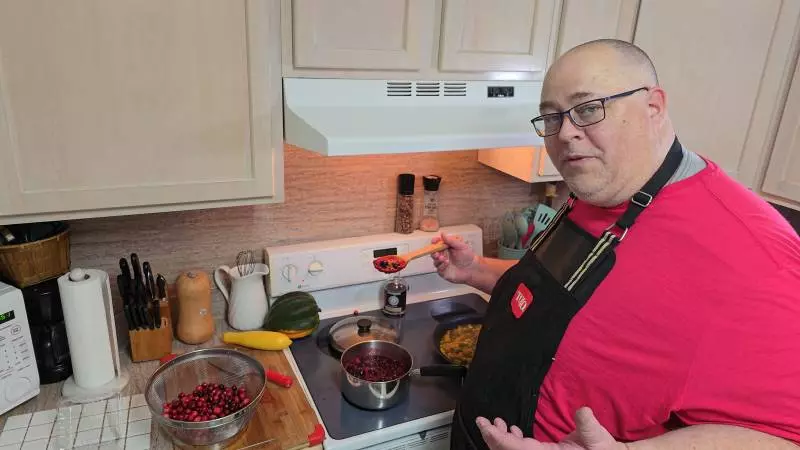
Once again though, the choice is yours - this cranberry sauce can be served chilled or at room temperature or as a warm side dish on your holiday table. Thankfully, it can also re-heat easily so ultimately you can have the best of both worlds!
